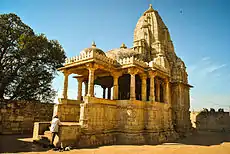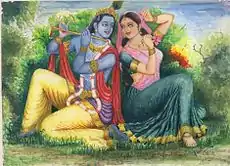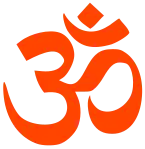Meera
Meera, also known as Mirabai[2] (मीराबाई; c.1498–c.1546), was a 16th-century Hindu mystic poet and devotee of Lord Krishna. She is a celebrated Bhakti saint, particularly in the North Indian Hindu tradition.[3][4]
Meera | |
|---|---|
 Raja Ravi Varma's painting of Meera Bai | |
| Other names |
|
| Personal | |
| Born | c.1498[1] |
| Died | c.1573, Dwaraka |
| Religion | Hinduism |
| Spouse | Bhojraj Singh Sisodia |
| Known for | Poet Bhakti movement, Vaishnavism (Lord Krishna) |
| Other names |
|
| Part of a series on |
| Vaishnavism |
|---|
 |
|
|
Mirabai was born into a Rajput royal family in Kudki, Pali district, Rajasthan, Mira then spent her childhood in Merta, Rajasthan. She is mentioned in Bhaktamal, confirming that she was widely known and a cherished figure in the Bhakti movement culture by about 1600 CE.[5] Most legends about Meera mention her fearless disregard for social and family conventions, her devotion to Lord Krishna, her treating Lord Krishna as her husband and being persecuted by her in-laws for her religious devotion.[1][5] She has been the subject of numerous folk tales and hagiographic legends, which are inconsistent or widely different in details.[1][6] Millions of devotional hymns in passionate praise of Lord Krishna are attributed to Meerabai in the Indian tradition, but just a few hundred are believed to be authentic by scholars, and the earliest written records suggest that except for two hymns, most were written down only in the 18th century.[7] Many poems attributed to Meera were likely composed later by others who admired Meera. These hymns are commonly known as bhajans, and are popular across India.[8] Hindu temples, such as in Chittorgarh fort, are dedicated to Mira Bai's memory.[1] Legends about Meera's life, of contested authenticity, have been the subject of movies, comic strips and other popular literature in modern times.[9]
Biography

Authentic records about Meera are not available, and scholars have attempted to establish Meera's biography from secondary literature that mention her, and wherein dates and other moments. Meera unwillingly married Bhoj Raj, the crown prince of Mewar, in 1516.[10][11] Her husband was wounded in one of the ongoing wars with the Delhi Sultanate in 1518, and he died of battle wounds in 1521. Both her father and father-in-law (Rana Sanga) died a few days after the battle of Khanwa in exile as they had vowed not to return to Mewar until they had defeated Babur.
After the death of her father-in-law Rana Sanga, Vikram Singh became the ruler of Mewar. According to a popular legend, her in-laws tried many times to assassinate her, such as sending Meera a glass of poison and telling her it was nectar or sending her a basket with a snake instead of flowers.[2][10] According to the hagiographic legends, she was not harmed in either case, with the snake miraculously becoming a Krishna idol (or a garland of flowers depending on the version).[6][10] In another version of these legends, she is asked by Vikram Singh to go drown herself, which she tries but she finds herself floating on water.[12] Yet another legend states that the Mughal emperor Akbar came with Tansen to visit Meera and presented a pearl necklace, but scholars doubt this ever happened because Tansen joined Akbar's court in 1562, 15 years after she died.[12] Similarly, some stories state that Guru Ravidas was her guru (teacher), but there is no corroborating historical evidence for this. Some versions suggest this could likely have happened. Others disagree.[12]
The three different oldest records known as of 2014 that mention Meera,[13] all from the 17th century and written within 150 years of Meera's death, neither mention anything about her childhood or circumstances of her marriage to Bhojraj, nor do they mention that the people who persecuted her were her in-laws or from some Rajput royal family.[14] Nancy Martin-Kershaw states that to the extent Meera was challenged and persecuted, religious or social conventions were unlikely to have been the cause, rather the likely cause were political chaos and military conflicts between the Rajput kingdom and the Mughal Empire.
Other stories state that Mira Bai left the kingdom of Mewar and went on pilgrimages. In her last years, Meera lived in Dwarka or Vrindavan, where legends state she miraculously disappeared by merging into an idol of Krishna in 1547.[1][2] While miracles are contested by scholars for the lack of historical evidence, it is widely acknowledged that Meera dedicated her life to Lord Krishna, composing songs of devotion and was one of the most important poet-saint of the Bhakti movement period.[2][12][15]
Poetry

A number of compositions by Meera Bai continue to be sung today in India, mostly as devotional songs (bhajans) though nearly all of them have a philosophical connotation.[17] One of her most popular compositions remains "Paayoji maine Ram Ratan dhan paayo" (पायो जी मैंने राम रतन धन पायो।, "I have been given the richness of Lord Ram's blessing").[18][19] Meera's poems are lyrical padas (metric verses) in Rajasthani language.[12] While thousands of verses are attributed to her, scholars are divided in their opinion as to how many of them were actually penned by Meera herself.[20] There are no surviving manuscripts of her poetry from her time, and the earliest records with two poems credited to her are from early 18th-century, more than 150 years after she died.[7]
Hindi and Rajasthani
The largest collection of poems credited to her are in 19th-century manuscripts. Scholars have attempted to establish authenticity based on both the poem and Meera being mentioned in other manuscripts as well as from style, linguistics and form.[7][21] John Stratton Hawley cautions, "When one speaks of the poetry of Mirabai, then, there is always an element of enigma. (...) there must always remain a question about whether there is any real relation between the poems we cite and a historical Mira."[22]
In her poems, Krishna is a yogi and lover, and she herself is a yogini ready to take her place by his side into a spiritual marital bliss.[7] Meera's style combines impassioned mood, defiance, longing, anticipation, joy and ecstasy of union, always centred on Krishna.[21]
My Dark One has gone to an alien land.
He has left me behind, he's never returned, he's never sent me a single word.
So I've stripped off my ornaments, jewels and adornments, cut my hair from my head.
And put on holy garments, all on his account, seeking him in all four directions.
Mira: unless she meets the Dark One, her Lord, she doesn't even want to live.— Mira Bai, Translated by John Stratton Hawley[23]
Meera speaks of a personal relationship with Krishna as her lover, lord and mountain lifter. (Sanson Ki Mala Pe Simru Main Pi Ka Naam) is written by Meera Bai Shows her dedication towards Lord Krishna.The characteristic of her poetry is complete surrender.
After making me fall for you so hard, where are you going?
Until the day I see you, no repose: my life, like a fish washed on shore, flails in agony.
For your sake I'll make myself a yogini, I'll hurl myself to death on the saw of Kashi.
Mira's Lord is the clever Mountain Lifter, and I am his, a slave to his lotus feet.— Mira Bai, Translated by John Stratton Hawley[24]
Meera is often classed with the northern Sant bhaktis who spoke of Lord Sri Krishna.
Sikh literature
Prem Ambodh Pothi, a text attributed to Guru Gobind Singh and completed in 1693 CE, includes poetry of Mira Bai as one of sixteen historic bhakti saints important to Sikhism.[25]
Influence
| Part of a series on |
| Hinduism |
|---|
 |
|
Scholars acknowledge that Meera was one of the central poet-saints of the Bhakti movement which was during a difficult period in Indian history filled with religious conflicts. Yet, they simultaneously question the extent to which Meera was a canonical projection of social imagination that followed, where she became a symbol of people's suffering and a desire for an alternative.[26] Dirk Wiemann, quoting Parita Mukta, states,
If one accepts that someone very akin to the Mira legend [about persecution and her devotion] existed as an actual social being, the power of her convictions broke the brutal feudal relationships that existed at that time. The Mira Bai of the popular imagination, then, is an intensely anachronistic figure by virtue of that anticipatory radical democracy which propels Meera out of the historicity that remains nonetheless ascribed to her. She goes beyond the shadowy realms of the past to inhabit the very core of a future which is embodied within the suffering of a people who seek an alternative.
The continued influence of Meera, in part, has been her message of freedom, her resolve and right to pursue her devotion to deity Krishna and her spiritual beliefs as she felt drawn to despite her persecution.[26][27] Her appeal and influence in Indian culture, writes Edwin Bryant, is from her emerging, through her legends and poems, as a person "who stands up for what is right and suffers bitterly for holding fast to her convictions, as other men and women have", yet she does so with a language of love, with words painting the "full range of emotions that mark love, whether between human beings or between human and divine".[28]

English versions
Aliston and Subramanian have published selections with English translation in India.[29][30] Schelling[31] and Landes-Levi[32] have offered anthologies in the USA. Snell[33] has presented parallel translations in his collection The Hindi Classical Tradition. Sethi has selected poems which Mira composed presumably after she came in contact with Saint Ravidas.[34] and Meera Pakeerah.
Some bhajans of Meera have been rendered into English by Robert Bly and Jane Hirshfield as Mirabai: Ecstatic Poems.[35]
Popular culture

Composer John Harbison adapted Bly's translations for his Mirabai Songs. There is a documentary film A Few Things I Know About Her by Anjali Panjabi.[36] Two well-known films of her life have been made in India, Meera (1945), a Tamil language film starring M. S. Subbulakshmi, and Meera a 1979 Hindi film by Gulzar. TV series, Meera (2009–2010) was also based on her life.
Meera Bai's life has been interpreted as a musical story in Meera—The Lover…, a music album based on original compositions for some well known Meera bhajans, released 11 October 2009.[37]
The Meera Mahal in Merta is a museum dedicated to telling the story of Mirabai through sculptures, paintings, displays and a shaded garden.[38]
See also
References
- Usha Nilsson (1997), Mira bai, Sahitya Akademi, ISBN 978-8126004119, pages 1-15
- "Mira Bai". Encyclopædia Britannica. Archived from the original on 4 December 2018. Retrieved 30 July 2015.
- Karen Pechelis (2004), The Graceful Guru, Oxford University Press, ISBN 978-0195145373, pages 21-23, 29-30
- Neeti Sadarangani (2004), Bhakti Poetry in Medieval India: Its Inception, Cultural Encounter and Impact, Sarup & Sons, ISBN 978-8176254366, pages 76-80
- Catherine Asher and Cynthia Talbot (2006), India before Europe, Cambridge University Press, ISBN 978-0521809047, page 109
- Nancy Martin-Kershaw (2014), Faces of the Feminine in Ancient, Medieval, and Modern India (Editor: Mandakranta Bose), Oxford University Press, ISBN 978-0195352771, pages 162-178
- John Stratton Hawley (2002), Asceticism (Editors: Vincent Wimbush, Richard Valantasi), Oxford University Press, ISBN 978-0195151381, pages 301-302
- Edwin Bryant (2007), Krishna: A Sourcebook, Oxford University Press, ISBN 978-0195148923, page 254
- Edwin Bryant (2007), Krishna: A Sourcebook, Oxford University Press, ISBN 978-0195148923, page 242
- Usha Nilsson (1997), Mira bai, Sahitya Akademi, ISBN 978-8126004119, pages 12-13
- Nancy Martin-Kershaw (2014), Faces of the Feminine in Ancient, Medieval, and Modern India (Editor: Mandakranta Bose), Oxford University Press, ISBN 978-0195352771, page 165
- Usha Nilsson (1997), Mira bai, Sahitya Akademi, ISBN 978-8126004119, pages 16-17
- These are Munhata Nainsi's Khyat from Jodhpur, Prem Ambodh from Amritsar and Nabhadas's Chappay from Varanasi; see: JS Hawley and GS Mann (2014), Culture and Circulation: Literature in Motion in Early Modern India (Editors: Thomas De Bruijn and Allison Busch), Brill Academic, ISBN 978-9004264472, pages 131-135
- JS Hawley and GS Mann (2014), Culture and Circulation: Literature in Motion in Early Modern India (Editors: Thomas De Bruijn and Allison Busch), Brill Academic, ISBN 978-9004264472, pages 131-135
- John S Hawley (2005), Three Bhakti Voices: Mirabai, Surdas and Kabir in Their Times and Ours, Oxford University Press, ISBN 978-0195670851, pages 128-130
- Edwin Bryant (2007), Krishna: A Sourcebook, Oxford University Press, ISBN 978-0195148923, page 244
- Subramanian, VK (1 February 2005). Mystic songs of Meera (in Hindi and English). Abhinav publications. ISBN 8170174589. Archived from the original on 23 November 2018. Retrieved 23 November 2018.
- "Lyrics - Ram Ratan Dhan Paayo (Lata Mangeshkar rendition)". www.tophindilyrics.com. Top Hindi Lyrics. Archived from the original on 9 December 2018. Retrieved 23 November 2018.
- The poetry of Meera : a compendium of her songs translated in English (PDF). Poetry Hunter. Archived (PDF) from the original on 23 November 2018. Retrieved 23 November 2018.
- "Meera ke bhajan (Hindi)". www.hindividya.com. Hindi Vidya. Archived from the original on 23 November 2018. Retrieved 23 November 2018.
- Edwin Bryant (2007), Krishna: A Sourcebook, Oxford University Press, ISBN 978-0195148923, pages 244-245
- John Stratton Hawley (2002), Asceticism (Editors: Vincent Wimbush, Richard Valantasi), Oxford University Press, ISBN 978-0195151381, page 302
- John Stratton Hawley (2002), Asceticism (Editors: Vincent Wimbush, Richard Valantasi), Oxford University Press, ISBN 978-0195151381, page 303
- John Stratton Hawley (2002), Asceticism (Editors: Vincent Wimbush, Richard Valantasi), Oxford University Press, ISBN 978-0195151381, page 304
- JS Hawley and GS Mann (2014), Culture and Circulation: Literature in Motion in Early Modern India (Editors: Thomas De Bruijn and Allison Busch), Brill Academic, ISBN 978-9004264472, pages 113-136
- Dirk Wiemann (2008), Genres of Modernity: Contemporary Indian Novels in English, Rodopi, ISBN 978-9042024939, pages 148-149
- Parita Mukta (1998), Upholding the Common Life: The Community of Mirabai, Oxford University Press, ISBN 978-0195643732, pages viii-x, 34-35
- Edwin Bryant (2007), Krishna: A Sourcebook, Oxford University Press, ISBN 978-0195148923, page 245
- Mirabai, V. K. Subramanian, Mystic Songs of Meera, Abhinav Publications, 2006 ISBN 81-7017-458-9, ISBN 978-81-7017-458-5, Archived 26 June 2014 at the Wayback Machine
- Alston, A.J., The Devotional Poems of Mirabai, Delhi 1980
- Schelling, Andrew, For Love of the Dark One: Songs of Mirabai, Prescott, Arizona 1998
- Landes-Levi, Louise, Sweet On My Lips: The Love Poems of Mirabai, New York 1997
- Snell, Rupert. The Hindi Classical Tradition: A Braj Bhasa Reader, London 1991, pp 39, 104–109.
- Sethi, V.K.,Mira: The Divine Lover, Radha Soami Satsang Beas, Punjab 1988
- Bly, Robert / Hirshfield, Jane,Mirabai: Ecstatic Poems, Boston, Massachusetts 2004
- "Legend of Mira Bai retold by Anjali Panjabi". The Times of India. 4 October 2002. Archived from the original on 14 July 2013. Retrieved 23 September 2014.
- "Vandana Vishwas: Home". Archived from the original on 24 February 2020. Retrieved 12 October 2020.
- Sengar, Resham. "Experiencing the presence of Meerabai at Meera Mahal in Rajasthan". Times of India Travel. Archived from the original on 13 November 2019. Retrieved 21 February 2020.
Further reading
- Robert Bly and Jane Hirshfield (2004), Mirabai: Ecstatic Poems, Beacon Press, ISBN 978-0807063866
- Chaturvedī, Ācārya Parashurām(a), Mīrāʼnbāī kī padāvalī,(16. edition)
- Goetz, Hermann, Mira Bai: Her Life and Times, Bombay 1966
- Levi, Louise Landes. Sweet on My Lips. The Love Poems of Mira Bai. Cool Grove PrBrooklyn NY,1997,2003,2016
- Mirabai: Liebesnärrin. Die Verse der indischen Dichterin und Mystikerin. Translated from Rajasthani into German by Shubhra Parashar. Kelkheim, 2006 (ISBN 3-935727-09-7)
- Hawley, John Stratton. The Bhakti Voices: Mirabai, Surdas, and Kabir in Their Times and Ours, Oxford 2005.
- Sethi, V.K.: Mira—The Divine Lover; Radha Soami Satsang Beas, Punjab, India; 1988
- Bankey Behari (1935). The Story of Mira Bai. Gorakhpur: Gita Press. OCLC 798221814.
External links
| Wikimedia Commons has media related to Meera (Mirabai). |
- Mīrābāī and Her Contributions to the Bhakti Movement, S. M. Pandey and Norman Zide (1965), History of Religions, Vol. 5, No. 1, pages 54–73
- Mirabai in Rajasthan, Parita Mukta (1989)
- Feminist and Non-Western Perspectives in the Music Theory Classroom: A Study of John Harbison's "Mirabai Songs, Amy Carr-Richardson (2002), College Music Symposium, Vol. 42, pages 20–36
- Without Kṛṣṇa There Is No Song, David Kinsley (1972), History of Religions, Vol. 12, No. 2, pages 149-180
- "By the Sweetness of the Tongue": Duty, Destiny, and Devotion in the Oral Life Narratives of Female Sādhus in Rajasthan, Antoinette E. DeNapoli (2009), Asian Ethnology, Vol. 68, No. 1, pages 81–109